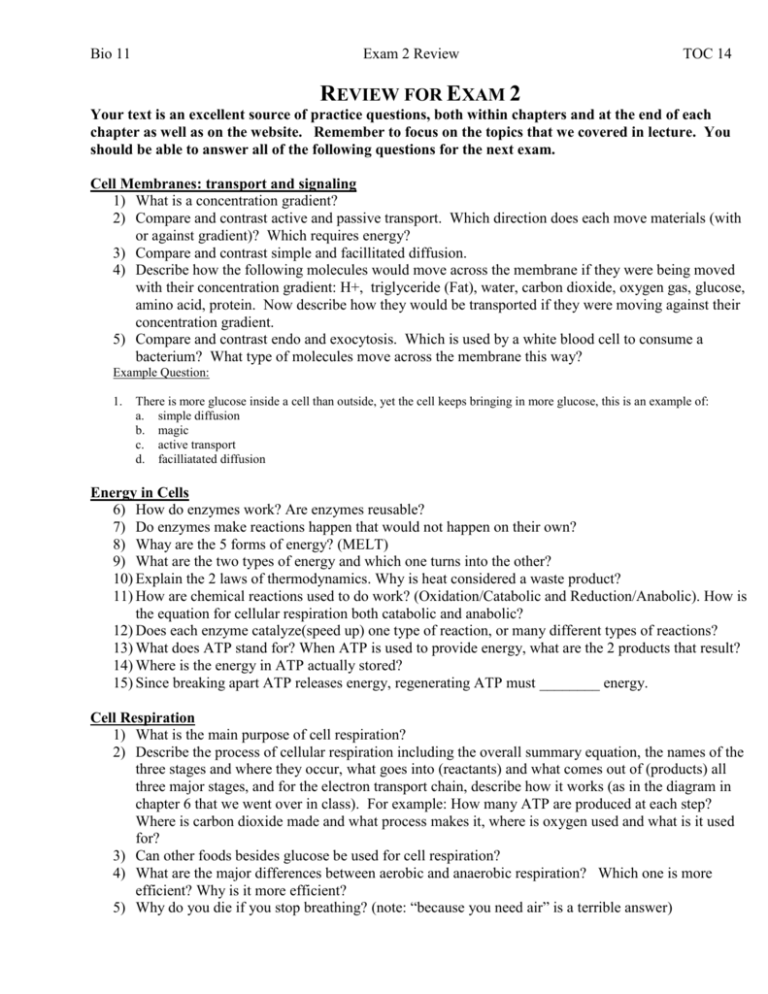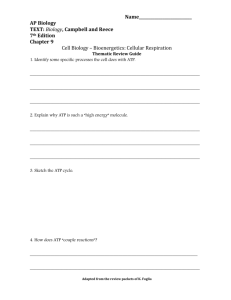BIOLOGY 10 REVIEW FOR EXAM 2
advertisement

Bio 11 Exam 2 Review TOC 14 REVIEW FOR EXAM 2 Your text is an excellent source of practice questions, both within chapters and at the end of each chapter as well as on the website. Remember to focus on the topics that we covered in lecture. You should be able to answer all of the following questions for the next exam. Cell Membranes: transport and signaling 1) What is a concentration gradient? 2) Compare and contrast active and passive transport. Which direction does each move materials (with or against gradient)? Which requires energy? 3) Compare and contrast simple and facillitated diffusion. 4) Describe how the following molecules would move across the membrane if they were being moved with their concentration gradient: H+, triglyceride (Fat), water, carbon dioxide, oxygen gas, glucose, amino acid, protein. Now describe how they would be transported if they were moving against their concentration gradient. 5) Compare and contrast endo and exocytosis. Which is used by a white blood cell to consume a bacterium? What type of molecules move across the membrane this way? Example Question: 1. There is more glucose inside a cell than outside, yet the cell keeps bringing in more glucose, this is an example of: a. simple diffusion b. magic c. active transport d. facilliatated diffusion Energy in Cells 6) How do enzymes work? Are enzymes reusable? 7) Do enzymes make reactions happen that would not happen on their own? 8) Whay are the 5 forms of energy? (MELT) 9) What are the two types of energy and which one turns into the other? 10) Explain the 2 laws of thermodynamics. Why is heat considered a waste product? 11) How are chemical reactions used to do work? (Oxidation/Catabolic and Reduction/Anabolic). How is the equation for cellular respiration both catabolic and anabolic? 12) Does each enzyme catalyze(speed up) one type of reaction, or many different types of reactions? 13) What does ATP stand for? When ATP is used to provide energy, what are the 2 products that result? 14) Where is the energy in ATP actually stored? 15) Since breaking apart ATP releases energy, regenerating ATP must ________ energy. Cell Respiration 1) What is the main purpose of cell respiration? 2) Describe the process of cellular respiration including the overall summary equation, the names of the three stages and where they occur, what goes into (reactants) and what comes out of (products) all three major stages, and for the electron transport chain, describe how it works (as in the diagram in chapter 6 that we went over in class). For example: How many ATP are produced at each step? Where is carbon dioxide made and what process makes it, where is oxygen used and what is it used for? 3) Can other foods besides glucose be used for cell respiration? 4) What are the major differences between aerobic and anaerobic respiration? Which one is more efficient? Why is it more efficient? 5) Why do you die if you stop breathing? (note: “because you need air” is a terrible answer) Bio 11 Exam 2 Review TOC 14 6) If an animal cell needs ATP to make a polymer, where does the ATP come from? If a plant cell needs ATP to make a polymer, where does the ATP come from? 7) You breathe out carbon dioxide as a waste product of cell respiration. What molecule did that carbon dioxide come from originally? 8) You make water as a byproduct of cell respiration. Where did the oxygen come from in that water molecule? Where did the hydrogen come from in that water molecule? 9) Be able to identify structures and molecules from cell respiration in a diagram (as in the activities quiz in mastering) Plants: 10) Know the 6 plant properties 11) What are the 4 problems with life on land, and how did plants address each? 12) What is unique about the plant life cycle? 13) How do you read a phylogenetic tree? 14) Tell the story of the evolution of plant reproduction from water algea to flowers. 15) Explain 4 ways plants use flowers to attract pollinators. Photosynthesis: 16) Why are most plant leaves green? Why are some other leaves not green (like a plum tree leaf)? 17) Why do leaves change color in the fall? 18) What is the main purpose of photosynthesis? 19) Describe the process of photosynthesis including what goes into (reactants), and what comes out of (products), both major stages. Where does each stage occur? 20) The light dependent reactions of photosynthesis make ATP, why doesn’t the plant just use that ATP, why does it go on to the Calvin Cycle to make glucose? 21) Why do plants need water? Carbon dioxide? How do they make oxygen? 22) Do plants turn carbon dioxide into oxygen? 23) Be able to identify structures and molecules from photosynthesis in a diagram 24) How is the electron transport chain in the mitochondria similar to the one in the chloroplast? How are they different? Example Question: 1. Why do plants need water? a. they need it for a hydrogen source for making sugar b. they need it to make oxygen c. they need it to make carbon dioxide d. they use it as a final electron acceptor Mitosis and Meiosis: (Use the other review sheets on the webpage to get a better review of Mitosis and Meiosis) 1. What are two types of mutation that are involved in cancer and how can mutations in the genes that code for these proteins lead to cancer? 2. Explain how non-disjunction causes Down’s Syndrome. What other types of non-disjuction lead to living offspring? 3. If given a starting number of chromosomes, be able to draw and/or recognize the results after that cell has gone through mitosis or meiosis. (ex: how many chromosomes will it have and which chromosomes will be in the gamete – answer: half as many as the starting number and 1 chromosome from each homologous pair) 4. What are the pros and cons of asexual and sexual reproduction? 5. What are the three ways to increse genetic diversity in the next generation, and how does each accomplish that? Bio 11 Exam 2 Review TOC 14








